�
�
�
�
�
�
�
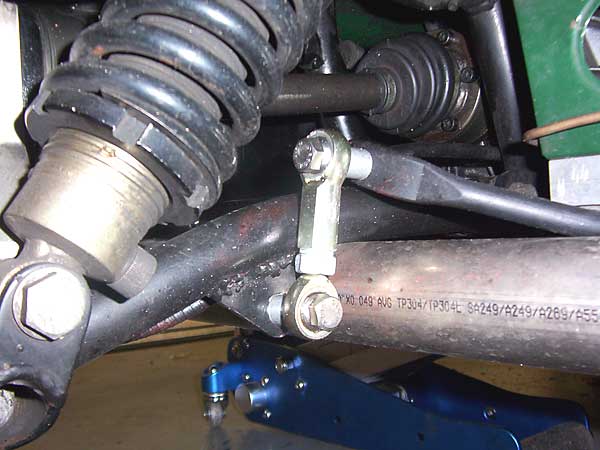
� �
� by: Larry Shimp�
�
�
�

�
Hoyle IRS Suspension Mods: New Anti-Sway Bar and Stronger Axles
� as published in British V8 Newsletter, Volume XIV Issue 3, December 2006�� by: Larry Shimp�
�
�
(Editor's note: this article provides follow-up information to Larry's previous �
article �
"Hoyle Suspension Upgrades for the MGB" which appears in British V8 �
Newsletter, Volume 13 Issue 1, January 2005.)�
�
Since the British V8 meet in June, I've replaced the axle shafts with stronger, �
custom made items. This was required because I broke one of the original shafts �
and twisted the other... I also found a way to install an MG Midget rear sway bar �
to the Hoyle suspension. (See photos below.) I've discovered I can fit 16 x 7 �
wheels with 215 width tires, with no fender flares. This is an advantage of setting �
2 degrees of negative rear camber! However, the wheels and tires will have to �
wait until later. �
�
�
� Body lean on corners isn't desirable because: 1) as a car leans, the suspension � geometry changes unfavorably, 2) weight is transferred to the outside tires, � reducing the load on the inside tires and thus the total available traction, � and 3) responsiveness is reduced because the car does not take a stable line � until it has finished leaning.�
� Body lean can be reduced by fitting stiffer springs, or sway bars, or both. � In general, sway bars are a better alternative to stiffer springs because real � world road surfaces aren't ideal. With stiff springs, the wheels are more likely � to bounce over the road surface, and when the wheels are not on the ground, � they are not guiding the car. Soft springs with good damper control usually � work well as far as maintaining tire contact, but then body lean becomes a � problem. This is where sway bars can help. They have minimal effect on bump � response, but can be very effective in keeping lean under control.�
�
�
�
Rear Sway Bar:
� I like the Hoyle Engineering independent rear suspension, but like the � stock MGB-GT rear suspension, it doesn't come with any provision for an � anti-sway bar. �� Body lean on corners isn't desirable because: 1) as a car leans, the suspension � geometry changes unfavorably, 2) weight is transferred to the outside tires, � reducing the load on the inside tires and thus the total available traction, � and 3) responsiveness is reduced because the car does not take a stable line � until it has finished leaning.�
� Body lean can be reduced by fitting stiffer springs, or sway bars, or both. � In general, sway bars are a better alternative to stiffer springs because real � world road surfaces aren't ideal. With stiff springs, the wheels are more likely � to bounce over the road surface, and when the wheels are not on the ground, � they are not guiding the car. Soft springs with good damper control usually � work well as far as maintaining tire contact, but then body lean becomes a � problem. This is where sway bars can help. They have minimal effect on bump � response, but can be very effective in keeping lean under control.�
�
�
Most MGBs are fitted with a front bar only. (Note: early roadsters came from the �
factory with a 9/16" front bar only. All GTs came from the factory with a 5/8" front �
bar only. For a couple years after converting to rubber bumpers, MG failed to fit �
any anti-sway bars at all to the roadsters... but that was madness. After they came �
to their senses, MG fit both front and rear bars on roadsters until the end of �
production.) To reduce sway, the stock anti-sway bars have often been upgraded by �
owners to a 3/4" or 7/8" bar. This is effective in keeping the body more level, but �
the extra roll resistance is transferred to the outside front wheel. This can �
overload the tire, and cause understeer. In extreme cases, cornering grip will be �
little better than when no sway bar is fitted, although the reduced lean will still �
make the car feel more responsive. �
� However, better suspension geometry also increases the effectiveness of wider tires, � and better tires certainly increase cornering grip. For example, we have all seen � pictures of old street/race cars where the inside front tire is off the ground � on a hard corner (extra chassis stiffness from a roll cage also helps). For � better balance, adding a rear bar is a good idea. A rear bar transfers some of the � roll resistance to the outside rear wheel which reduces the load on the outside � front tire, thus increasing the front grip and reducing understeer. In the rear, � the inner tire will lose some loading, and wheel spin becomes more likely in a car � without a limited slip differential. However, if the roll resistance is chosen � properly, the compromise between weight transfer, suspension geometry, and roll � resistance transfer will result in a higher cornering grip, and a more neutral feel. �
��
�
� A general rule is that the rear bar should be weaker than the front bar. This � helps to make the car understeer at the limit, which is much more controllable � than oversteer at the limit. (Remember the reputation early Porsche 911s had?)� With a more evenly balanced car like an MGB, it is quite easy to overdo the rear � sway bar and induce dangerous oversteer. (Maybe with a 4 cylinder car this can be fun, � but with the power and acceleration of a V8 MGB it becomes a handful!)�
� My MGB was previously fitted with a 7/8" front anti-sway bar, and I decided to fit � a rear bar to help balance it. The Hoyle suspension did not come with any provision � for a rear bar, so I started looking for something that I could adapt.�
� Because the MGB is very narrow by contemporary standards, there are few � bars that could fit. I confined my search to similar narrow cars and decided � that a Midget/Sprite front bar would probably fit. So I went ahead and ordered � the complete set of parts including links and brackets. Upon arrival, a test � fit showed that this bar would indeed package neatly. I continued with the � installation.�
� To begin, I cut the brackets attaching the links to the Midget front A-arms � to a different shape and welded them to the lower front sections of the rear � A-arms just outside of the exhaust. I cut the links and welded them back � together so the two fittings were at 90 degrees to each other. Then I made � spacers from 1 inch thick aluminum plate to attach the bar to the bottom of � the battery boxes. That was all there was to it.�
��
�
The rear sway bar made a noticeable improvement: the steering is more �
responsive, cornering grip seems higher and is very neutral in feel, and �
the car is more stable at all speeds. It was also very evident that traction �
was greatly improved in low speed, second gear corners. Overall, the sway �
bar has increased the overall level of confidence in the car. This was a �
very worthwhile project. �
�
�
� However, better suspension geometry also increases the effectiveness of wider tires, � and better tires certainly increase cornering grip. For example, we have all seen � pictures of old street/race cars where the inside front tire is off the ground � on a hard corner (extra chassis stiffness from a roll cage also helps). For � better balance, adding a rear bar is a good idea. A rear bar transfers some of the � roll resistance to the outside rear wheel which reduces the load on the outside � front tire, thus increasing the front grip and reducing understeer. In the rear, � the inner tire will lose some loading, and wheel spin becomes more likely in a car � without a limited slip differential. However, if the roll resistance is chosen � properly, the compromise between weight transfer, suspension geometry, and roll � resistance transfer will result in a higher cornering grip, and a more neutral feel. �
�
| �
Enjoying this article? Our magazine is funded through the generous support of readers like you! � To contribute to our operating budget, please click here and follow the instructions. � (Suggested contribution is twenty bucks per year. Feel free to give more!)� |
� A general rule is that the rear bar should be weaker than the front bar. This � helps to make the car understeer at the limit, which is much more controllable � than oversteer at the limit. (Remember the reputation early Porsche 911s had?)� With a more evenly balanced car like an MGB, it is quite easy to overdo the rear � sway bar and induce dangerous oversteer. (Maybe with a 4 cylinder car this can be fun, � but with the power and acceleration of a V8 MGB it becomes a handful!)�
� My MGB was previously fitted with a 7/8" front anti-sway bar, and I decided to fit � a rear bar to help balance it. The Hoyle suspension did not come with any provision � for a rear bar, so I started looking for something that I could adapt.�
� Because the MGB is very narrow by contemporary standards, there are few � bars that could fit. I confined my search to similar narrow cars and decided � that a Midget/Sprite front bar would probably fit. So I went ahead and ordered � the complete set of parts including links and brackets. Upon arrival, a test � fit showed that this bar would indeed package neatly. I continued with the � installation.�
� To begin, I cut the brackets attaching the links to the Midget front A-arms � to a different shape and welded them to the lower front sections of the rear � A-arms just outside of the exhaust. I cut the links and welded them back � together so the two fittings were at 90 degrees to each other. Then I made � spacers from 1 inch thick aluminum plate to attach the bar to the bottom of � the battery boxes. That was all there was to it.�
�
 | �
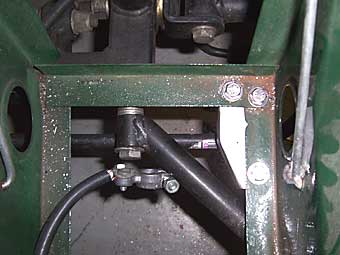 | �
| �
Aluminum spacers... | �
� ...go under the battery boxes to hold the sway bar brackets. | �
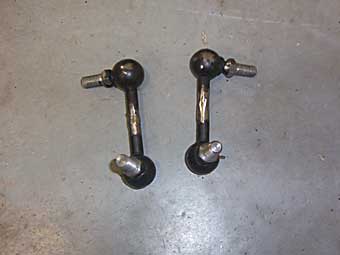 | �
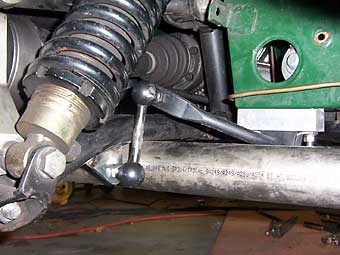 | �
| �
MG Midget attachment links were cut and re-welded. The welding must �
be done carefully (quickly) to avoid melting the rubber! | �
�
They worked... but I decided to replace them with adjustable links. �
Advantage: increased stiffness from eliminating the rubber ends. | �
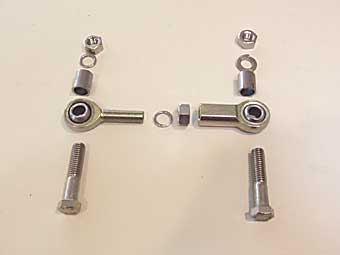 | �
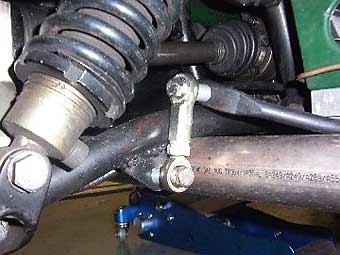 | �
| �
1/2 inch ID spacers (bought locally and cut to length). � The Heim joints are from www.pegasusautoracing.com | �
�
The Heim joints facilitate side-to-side adjustment. � There is actually more clearance here than it appears! | �
�
I have a limited slip differential which is usually recommended with a rear �
sway bar. However, I suspect that even with an open differential there �
would be very significant improvements; with the possible exception of the �
low speed second gear corners.�
� The 1/2" MG Midget rear bar seems a good compliment to my 7/8" front � sway bar. A 3/4" Midget bar is available, but it will not fit due to it � having longer arms than the 1/2" bar. The effectiveness of an anti-sway bar � isn't simply a function of its thickness. The stiffness of its mounting and the � mechanical advantage of the lever-arms that act on it also factor in. The short � arms of the 1/2" MG Midget bar mean that it provides more roll resistance than � a 9/16" MGB front bar. ��
�
� Disclaimer: This page was researched and written by Larry Shimp. Views expressed � are those of the author, and are provided without warrantee or guarantee. Apply at your � own risk.�
� Photos by Larry Shimp. All rights reserved. �
�
�
� The 1/2" MG Midget rear bar seems a good compliment to my 7/8" front � sway bar. A 3/4" Midget bar is available, but it will not fit due to it � having longer arms than the 1/2" bar. The effectiveness of an anti-sway bar � isn't simply a function of its thickness. The stiffness of its mounting and the � mechanical advantage of the lever-arms that act on it also factor in. The short � arms of the 1/2" MG Midget bar mean that it provides more roll resistance than � a 9/16" MGB front bar. �
Axle Shafts:
� There is also bad news. I broke one rear axle shaft and twisted the other! � The Hoyle suspension uses shortened Merkur/Scorpio axles. To shorten them, � a section of larger diameter tubing has been fitted as a "splice" in the � center of each shaft and it's welded at either end. Diameter changes and � welds create stress risers, so perhaps it should be no surprise that this � is where the shafts broke. I ordered custom replacement shafts from Dutchman � Motor Sports in Portland, Oregon. These are of a constant diameter and are � made of high grade chrome-vanadium steel. For what they cost I expect them � to last forever.�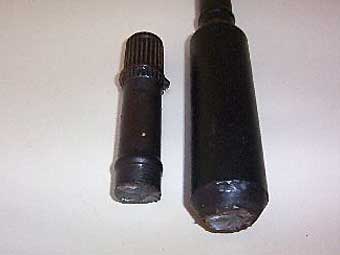 | �
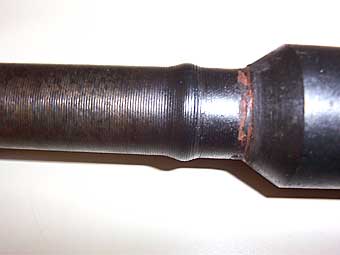 | �
| �
Fatigue failure: broken axle shaft. | �
�
The other axle shaft had cracked too. | �
�
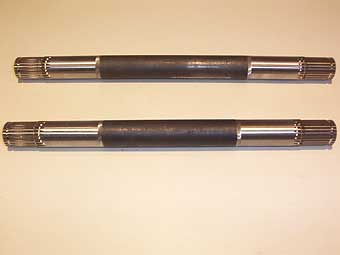 | �
|
| � Better design: unspliced axle shafts. | �|
� Disclaimer: This page was researched and written by Larry Shimp. Views expressed � are those of the author, and are provided without warrantee or guarantee. Apply at your � own risk.�
� Photos by Larry Shimp. All rights reserved. �

